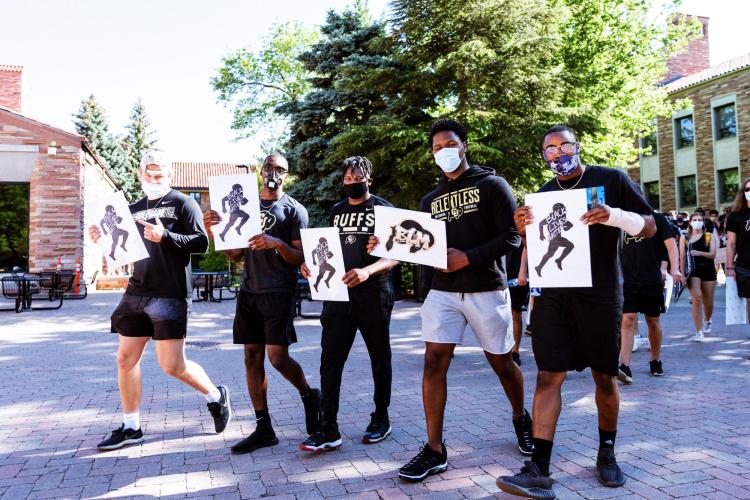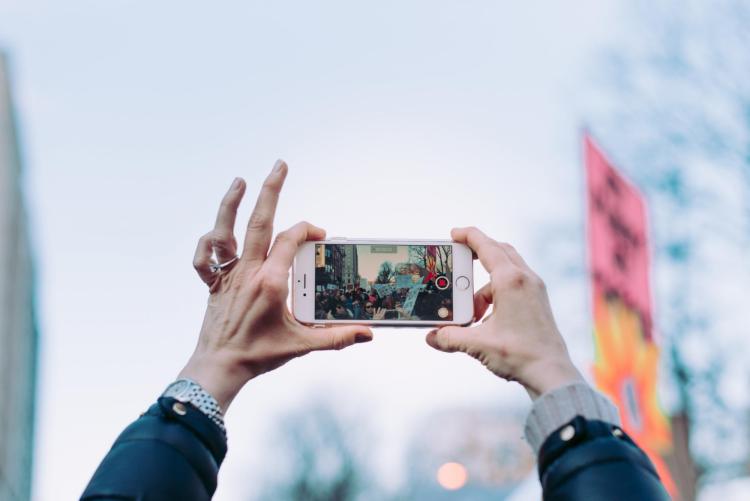One year later: How George Floyd’s death changed us
Banner image: A mural at a memorial site for George Floyd. Photo by munshots on Unsplash.
On May 25, 2020, then-police officer Derek Chauvin murdered Minneapolis resident George Floyd in full view of the public. Floyd’s death was caught on video and shared worldwide. In the days, weeks and months afterward, protests erupted around the globe in reaction to this lethal act of violence committed by a white police officer on a Black man.
One year later, CU Boulder researchers shared their expertise with CU Boulder Today, examining four areas in which the United States has––and hasn’t––changed since that day, and the potential lasting impacts on social and political movements, education, policing and justice across the country.

CU Boulder student athletes, administrators and community members marched from the Hill to the Pearl Street Mall in what was called the Buff March on June 5, 2020. (Credit: Bo Savage)
A spotlight on the Black Lives Matter movement
The Black Lives Matter movement was founded in 2013 by Black activists Alicia Garza, Patrisse Cullors and Opal Tometi in response to the acquittal of George Zimmerman, who shot and killed Trayvon Martin. It has been growing ever since.
But in the wake of Floyd’s death, the phrase “Black Lives Matter” rose to a prominence it has never had before. Its words were in people’s minds and on their lips, signs popped up in neighborhoods across the country and people marched in protests who had never done so before.
Reiland Rabaka, professor of ethnic studies and director of the newly announced Center for African and African American Studies, noticed a significant shift in how his community responded to Floyd’s death, compared to the news of other Black Americans killed under similarly violent circumstances in recent years.
“Something did happen very differently with the video footage of George Floyd, we have to be honest about that. It shook people even in spaces like Boulder, Colorado,” said Rabaka, who is African American. “They don't realize how we're treated, that those kinds of things are still happening to us.”
Reiland teaches a course on the Black Lives Matter movement, and while the course has always been popular, he received renewed, eager interest from students and the local community to enroll in the spring of 2021. While it is unknown if the movement will continue to receive the same level of support and attention it has this past year, Rabaka is committed to educating students and the public about it.
Increased interest in anti-racism education
This past year, the United States’ vocabulary expanded to include “anti-racism.” It provides a word to describe the attitude and acts of those actively engaged in dismantling systemic and institutional racism––racism embedded through laws within society or an organization––as well as racism in their everyday lives.
To help more people understand this term and learn how to be anti-racist, Jennifer Ho, professor of ethnic studies and director of the Center for Humanities and the Arts, and Shawn O’Neal, doctoral candidate in ethnic studies, created an online course on the educational platform Coursera. The course, Anti-Racism I, is free for the public.
“Education is always going to be one of the things we need to address systemic inequality, particularly around race and racism,” said Ho, who is Asian American.
Ho has seen an increase in demand for this type of educational content, not only in the wake of Floyd’s death, but also as a result of increased discrimination and violence against Asian Americans during the COVID-19 pandemic, which she has frequently spoken about this past year.
“There’s been an interest from the average person who wants to be able to do something different, who wants to be able to make a positive change,” said Ho.
Reimagining policing
The public are now paying more attention to the overlapping issues of race, policing and the U.S. criminal justice system, according to Ben Levin, associate professor of law.
“While these issues of race and police violence are hardly unprecedented,” said Levin, “what's so important about a moment like this is that it invites people who otherwise weren't focused on these issues to pay more attention.”
Colorado has seen more legislative action than in the past, due partly to the fact there are more eyes on the problem. For instance, Senate Bill 217 is designed to “enhance law enforcement integrity” through increased transparency and accountability. Signed into law on June 19, 2020, it allows individuals harmed by police officers to bring civil suits in state courts here in Colorado in a way that they might not be able to in the federal courts, said Levin.
“There's still a bigger question, though, about what the impact of this will be on the institution of policing,” said Levin. “We don’t know whether departments will respond to these suits by altering the way they do business or officers will be deterred from using force based on a greater chance of civil liability.”
But since June of 2020, the Denver Police Department has been working with a group of local organizations to run the Support Team Assistance Response program (STAR), where certain 911 calls are diverted to health professionals instead of police. According to a progress report, in its first six months the program responded to 748 incidents, none of which required police or led to arrests or jail time.
Primarily as a result of Floyd’s murder, police presence and reputation both took a hit nationwide in 2020, according to David Pyrooz, associate professor of sociology and faculty associate in the Institute of Behavioral Science.
In the second half of 2020, pedestrian and traffic stops in Denver fell by 50%, according to city and county data. That’s about 1,000 fewer stops made each week by police.
“That’s a remarkable change,” said Pyrooz. “But it was the image of the police that took the largest hit. Gallup polling showed that for the first time in three decades, less than a majority of the general public maintained confidence in the police.”
Yet at the same time, homicides are on the rise nationwide, and Denver is not exempt from this increase. Rising violent crime could pose challenges for those invested in reforming or reimagining police and changing how the system functions.
“Continued calls for more policing means that there's a heavy counterweight to any effort to move to decarceration, or to reduce reliance on policing and other criminal legal institutions,” said Levin.

Video footage has been in used in courtrooms as evidence for over 30 years, but with cell phones now constantly at hand, courtrooms are seeing an overwhelming amount of video footage in cases involving police violence. (Credit: Unsplash / Alice Donovan Rouse)
The role of video evidence in court
The use of video footage in a trial, as it was in Chauvin’s trial, is nothing new in the legal system, according to Sandra Ristovska, assistant professor of media studies. In fact, 30 years ago, video footage shot by a bystander was used in the courtroom during the historic trial of four Los Angeles police officers who brutally assaulted a Black man named Rodney King. That incident also kicked off a firestorm of national protests.
Today, with the advent of smartphones and police body cameras, courtrooms are seeing an overwhelming amount of video footage in cases involving police violence. In the case of Floyd’s death, one bystander captured an uninterrupted video more than nine minutes long. In addition to several more bystander videos, other video evidence included at least five different police body cameras, security footage inside the store and video from one city surveillance camera.
While in the trial of Derek Chauvin, the wide variety video evidence was consistent and corroborated by witness and expert testimonies, a surplus of video footage does not always bring us closer to justice. Video is just a fragment of evidence, Ristovska points out. It’s important to also consider what kind of narrative we construct around what we see and what other information exists to verify that narrative.
“We may all see the same thing. But we may arrive at a different interpretation,” said Ristovska. “We're prone to biases in how we interpret images.”
In the same way that eyewitness testimony has been studied and led to advances in our knowledge of how memories can be affected by persuasion or trauma, video may not be as reliable as we assume it to be, she said. For example, attorneys on either side of a case have the power to frame video evidence, which can influence what a juror pays attention to and how they interpret what they see.
Psychologists have already proven it’s possible to influence what a person does and does not see in a video, a principle known as selective attention. This principle is popularly demonstrated through a video used in the 1999 Harvard experiment, where viewers are instructed to count the number of times a basketball is passed between players wearing white T-shirts––while a person in a black gorilla suit walks through the scene, often completely unnoticed.
“Video is here to stay,” said Ristovska. “And the more we're seeing video, the more court systems need to think more carefully about the presentation of this evidence, the kind of instructions that juries should receive, and what training there should be for judges on the particularities of visual evidence and video.”


